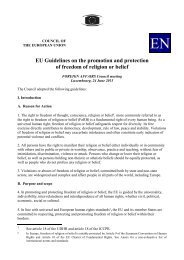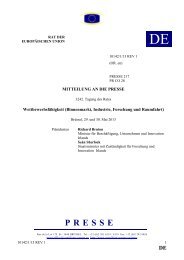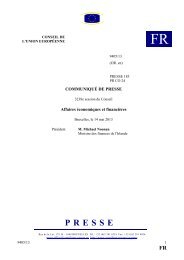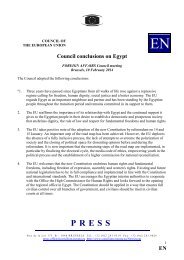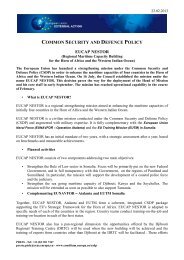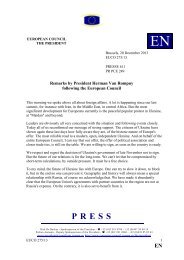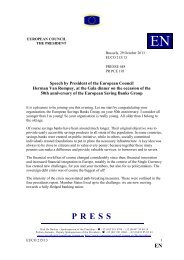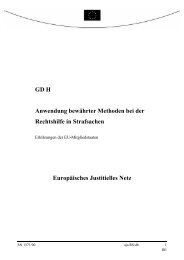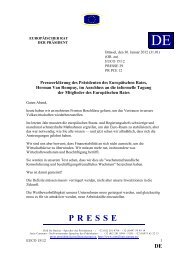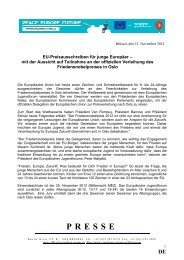14508/09 ADD 1 PL/vk 1 DG G COUNCIL OF THE ... - Europa
14508/09 ADD 1 PL/vk 1 DG G COUNCIL OF THE ... - Europa
14508/09 ADD 1 PL/vk 1 DG G COUNCIL OF THE ... - Europa
You also want an ePaper? Increase the reach of your titles
YUMPU automatically turns print PDFs into web optimized ePapers that Google loves.
Employment alone is not enough to protect single parents from poverty. In many countries the high<br />
poverty rates experienced by lone mothers coexist with an employment rate which matches or<br />
exceeds those of mothers in couple households yet still leaves lone mothers exposed to greater<br />
poverty risks (Fagan et al.2006). The risk of poverty for single parents is smallest in<br />
Denmark (17 %), Finland (22 %) and Sweden (24%). However, single parents in these countries are<br />
still economically disadvantaged compared with two-parent households, in Sweden they are also<br />
poorer when compared with elderly women. More than half of the single parents in Malta (54 %)<br />
are at-risk-of-poverty, which is the highest rate, followed by Luxembourg (54%), Estonia and UK<br />
(44 %), Lithuania (42 %) and Ireland (40 %) (EU-SILC 2007).<br />
Women in the EU MS, whether they are employed or unemployed, young or older, have a less<br />
secure life situation than men. Women face a greater risk than men of falling into poverty and this is<br />
especially the case for women from more vulnerable or marginalised groups (migrant and ethnic<br />
minority women, disabled women). For women entry into poverty mainly reflects family- and job-<br />
related events such as childbirth, divorce and widowhood.<br />
Indicator 3: An inactive person is defined as a person inactive in the labour market. It does not<br />
however mean that persons who are in this category are inactive in general. They can for example<br />
be taking care of children or incapacitated adults, doing domestic work or studying.<br />
The proportion of economically inactive women and men aged from 15-24 years is between 60 and<br />
80 % in several countries (Eurostat, EU-LFS, 2007). Country differences arise from differences in<br />
national education systems and school leaving ages and from rates of unemployment<br />
(Rubery et al. 2004). The differences between women and men are limited. The gender gap in the<br />
share of inactive persons is lowest in Sweden (-1 %), Finland (0 %) and the Netherlands (1 %) and<br />
highest in Slovenia, Latvia and Estonia (12 %). A higher share of “inactive” women might be a<br />
result of women studying longer than men.<br />
The share of inactive women in the age category 25-49 ranges from 10 % in Slovenia and 52 % in<br />
Malta and the gap between women and men differs ranges from 3 % in Slovenia to 48 % in Malta<br />
(Eurostat, EU-LFS, 2007). It is in this age category we find the highest share of women and men in<br />
employment, but also where childcare responsibilities for women are the most intensive. The<br />
gender inactivity gap is 15 % in EU27; it ranges from 3 % in Slovenia to 48 % in Malta.<br />
<strong>14508</strong>/<strong>09</strong> <strong>ADD</strong> 1 <strong>PL</strong>/<strong>vk</strong> 54<br />
ANNEX <strong>DG</strong> G EN



